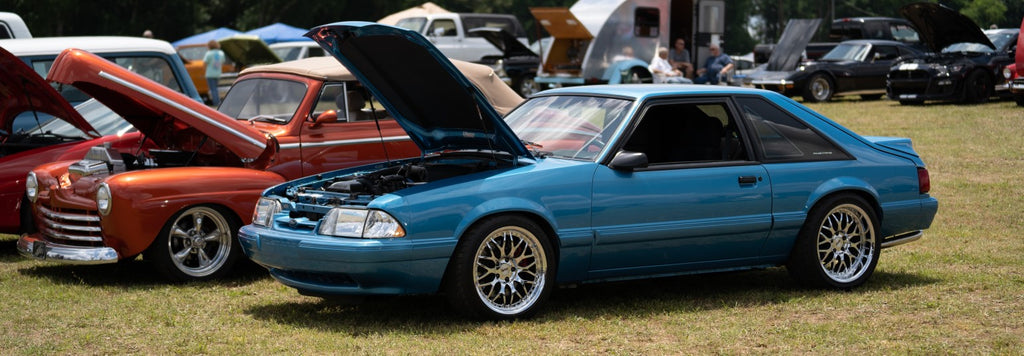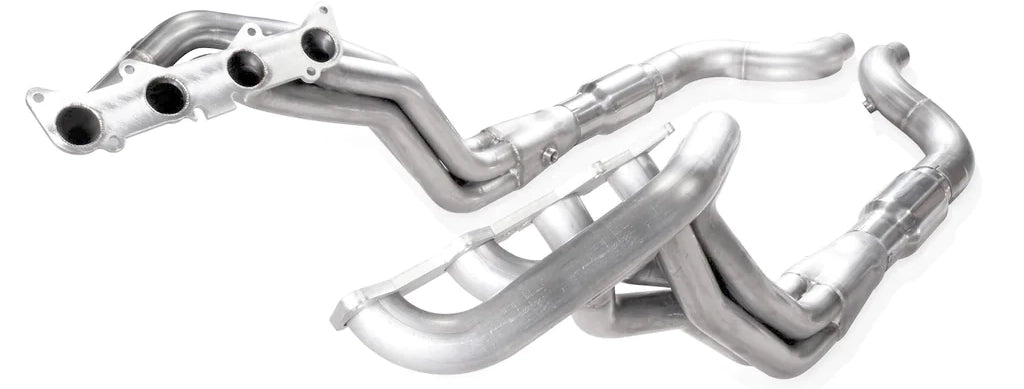
From the Pony Car and Fastbacks to the S650
There’s no doubt that the Ford Mustang has had a long and fruitful journey. This modern-day marvel got its not-so-humble start when it was unveiled by Henry Ford II in April of 1964 at the World’s Fair. This sort of unveiling wasn’t uncommon for the Ford Motor Company as Henry Ford I was a huge believer in the World’s Fair exhibits to educate potential consumers of their goings on. In this blog, we’re going to talk a lot about one of the longest runs that any sportscar has had without interruption.
“One of”, you say? Yes, three sportscars have had a longer-lived name than the Mustang. They are, in no specific order:
- The Chevy Corvette was introduced in 1953.
- The Porsche 911 first went to market in 1963.
- And which may be a little surprising to some, the Prince Skyline was first produced in 1957 as a luxury car. Nissan and Prince merged in 1966 and by 1968 Nissan developed the 1969 Skyline 2000 GTR. This was the first of the Skyline models to be performance-based and bred for speed. So it’s not TECHNICALLY a longer running “sportscar” than the Mustang but let’s not forget the 1974-1978 Pintostang that was a compact, more fuel-efficient “luxury Mustang” called the Mustang II. We will get this triumph for Ford in a bit.
Mustang’s Generation 1 (1964-1973), The Beginning of a Legacy:

The original Mustang was an instant hit when it was introduced in 1964, due in part to how it was marketed but we can’t throw shade on the car itself. Marketing aside, the car would not have been such a success if its design wasn’t so desirable. There had never been anything on the market like it. So much so, the term “Pony Car” was coined for the Mustang which inspired a handful of successful imitations, like the Camaro, Firebird, and Challenger. There were also several cars that we can’t call failures but due to a soon-saturated market, they decided to stick to the most popular three. Some of the gone but not forgotten Pony Cars were the Oldsmobile Rallye 350, the Ford Torino Talladega, and the Barracuda.
Over the nine-ish years that the first generation spanned, there were some notable modifications and some may say “upgrades” and different trim levels. The Mustang Fastback design was introduced in August of 1964 which gave the rear of the cabin a more rounded or extended look as it sloped more towards the taillights than the original. This design just screamed SPEED in its aesthetic alone. The car just looked like it would be fast. The Fastback experienced a redesign in 1967 and became Bullitt’s ride of choice in Steve McQueen’s hit movie Bullitt. The original 1964 Mustang was also used in Sean Connery’s classic Bond film Goldfinger… And whatever happened to films with just one-word titles?

In 1969, Ford started making more changes to the Mustang that could’ve warranted generation change but they didn’t. The Mustang became noticeably longer that its previous designs with no trim levels including the Mach1 and the Boss, which sported new performance packages further keeping their imitators on their toes. The 1969 and 1970 Mustangs are some of the most sought-after models today and will fetch a pretty penny when found in poor condition and a well-polished silver dollar if found in mint condition or restored.
Striving to improve on its flagship automobile, Ford soon realized that Its 1972 and 73 Mustangs were getting a little bulky and needed to go on a diet. Did that pendulum swing too far in the other direction? Some may think so.
1974-1978 Mustang II "The Pintostang", A Legacy Tainted?
 1978 Ford Mustang II King Cobra: This image was originally posted to Flickr by Cars Down Under. It was confirmed to be licensed under the terms of the cc-by-2.0.
1978 Ford Mustang II King Cobra: This image was originally posted to Flickr by Cars Down Under. It was confirmed to be licensed under the terms of the cc-by-2.0.
Many cynics in the auto world don’t like to give the 1974-1978 Mustang II its due but we are here to set the record straight. The Mustang II or as it was affectionately referred to, the “Pintostang”, though it didn’t carry all of the beloved hallmarks of the original Mustang, its redesign created its own place in history. Built on the Pinto chassis, this four-banger engine gave the driver a fuel-efficient yet peppy driving experience as an upscale economy car. This move was strategic because of the looming oil crisis. On the shorter frame, it was smaller and lighter than the Mustangs that came before it, which were widely seen as “the working man’s sports car.”
A couple of accomplishments that came out of the second generation include sales numbers that nearly rivaled that of the 1964 Mustang, and it won Motor Trend’s Car of the year which was something Mustang hasn’t been able to muster again for another 20 years or so. BUT when the oil crisis ended in early 1975, Ford didn’t have any real contenders for the muscle car market. This brought out a new V8 option for the 1975 Mustangs and the whole new 1976 Mustang Cobra II Fastback, which was oddly available in every engine, the 4-cylinder, the 6-cylinder, and a very powerful V8 for an incredibly light frame. The Cobra II earned some street cred as a race car when a modded version entered the IMSA (International Motor Sports Association) GT Class. It made quite the impression.
Let’s not forget the frontend tube suspension with rack and pinion steering that made its debut in the “Pintostang” and is still used in performance cars today. Tainted? I think not.
The 1978 Mustang “King Cobra” with new design elements like the giant front bumper, racing stripes, King Cobra Badges, and a huge cobra decal on the hood made a statement on car lots and driveways across the country. Unfortunately, the V8 engine that came with whispered a mild 139 horsepower or ponies, if you will. But its price wasn’t bad and the V8 was faster than the 6 and 4-cylinders. It also had adjustable shocks for comfort and handling and a rear stabilizer bar for control. I wouldn’t hate taking one for a spin.
Third Generation of Mustang: The 1979-1993 Fox Body

The Fox Body was the longest-lived generation of all Mustangs, so far. Hey, if it ain’t broke, don’t fix it. This Mustang frame was shared among a couple of other cars from the Ford Motor Company family. With their long hoods and short cab and trunk, the Mercury Zephyr, Ford Fairmont, and Mercury Capri are all vehicles that may be mistaken for a third-generation Mustang if you’re squinting whilst looking through a dirty window. Some even compare this design to European or JDM sportscars with square lines and headlights.
The 1979-1993 Mustang came with a wide range of engines, similar to the earlier models. You had your pick between the inline 4-cylinder, a V6, or a 5.0L V8. In 1983, Ford introduced a turbocharged engine and a convertible top, further increasing the diversity of Mustang’s offerings. Around 1988 Ford manufactured the Mustang SSP for law enforcement, like State Troopers, giving them quite the edge over most villains in well-equipped cars. However, Ford leveled the playing field for civilians in 1993 with the swift SVT Mustang Cobra.
1994-2004 Ford Mustang: The Fourth Generation (SN95)
 1997 Ford Mustang Cobra Saleen: This image was originally posted to Flickr by Cars Down Under at . It was confirmed to be licensed under the terms of the cc-by-2.0.
1997 Ford Mustang Cobra Saleen: This image was originally posted to Flickr by Cars Down Under at . It was confirmed to be licensed under the terms of the cc-by-2.0.
The Ford Mustang turned 30 in 1994 and for this milestone birthday, it got a total redesign. Known as the SN95 Mustang, the designers decided to give a nod back to the first generation with a split dash or a twin cowl of sorts, where the passenger side dash was an identical shape to the driver’s side. While the very symmetrical interior reminisced of the Mustang from yesteryear, the exterior had a very bold, modern vibe with a bigger body than the Fox but more aerodynamic. Mechanically, Ford tested the waters in 94 and 96 with two different modular V8 engines, 5.0 and 4.6 respectively.
And what a birthday it was for America’s most beloved sportscar because the 1994 Mustang did it again with their GT. They celebrated being Motor Trend’s Car of the Year for a second time. The Mustang GT could go from 0-60 in about 6 seconds out of the box and was the predecessor of some truly innovative Mustang trims, like the 1999 SVT Cobra and Bullitt Mustangs.
This style of Mustang with its “New Edge” design sailed into the millennium with ease.
2005-2014 Mustang: The Fifth Generation (S197) – It’s Time for a Flashback

In 2005 Ford decided to go whole hog on the Mustang throwback to Gen 1 and paid serious tribute to the original Mustang “Pony Car” body design. This D2C (D-Class 2-Door Coupe) Mustang platform brought back the long hood and short deck with modern body lines that lovingly embrace the history of this legendary car. The throwback redesign by Ford was so successful that other major car companies (not naming names… Coughs “GM” Cough-Cough “MOPAR”. Excuse me. It’s weird that I typed my coughs, there) have again mimicked Ford in reviving some classic designs of their own. But who can blame them? It was apparently a VERY good idea.
To go a step further, Ford didn’t just recreate the general Ford body style from the 60s. No! They brought back some real classic head-turners like the Shelby Mustang. The Shelby GT500 and GT500KR boast a huge power boost at 662HP in a 5.0L engine. As if that wasn’t enough, a fifth-generation recreation of the 1968 Bullitt Mustang just had to be done.
The Coyote 5.0 Engine (Gen 1)
Let's not forget about Ford's introduction of the Coyote 5.0 V8 to Mustang's lineup of GTs and the Boss in 2012. This engine brought a Horsepower range of about 400 - 450 ponies, making it a super fast car straight out of the box. This engine also adorned the engine bay of the new Ford F150 pickup trucks with slightly lower horsepower. They did, however, keep the torque up on these trucks, making them beasts when it comes towing.
2015-2023 Ford Mustang: The 6th and Current Generation (S550)

2015 marked the 50th Anniversary of this iconic sportscar. This 6th generation of Mustang is sleek, sportier than ever, powerful, and still pays a huge homage to all of the Mustangs that came before it. With a large selection of trim options, motors, and even an all-electric 4-door sport sedan with all-wheel drive, that is SUPER fast, it seems like there is something for everyone.
One of the new features of Ford vehicles in general is a super zippy 2.3L EcoBoost 4-cylinder that has tremendous torque and surprisingly swift acceleration. In the Mustang, 2.3L EcoBoost has been tuned to be a little faster than the other Ford vehicles, it comes standard in, like the New Ranger. Let’s not forget that the new Mustang also has a 5-star rating from the National Highway Traffic Safety Administration (NHTSA).
The Coyote 5.0 Engine (Generations 2 and 3)
In 2015, the Coyote Mustang 5.0 engine was introduced in the GT and held that place until 2017. Producing a consistent 435 horsepower and 400 lb-ft in top end torque makes it hard to believe that they could improve on this monster of an engine but in 2018, they did just that.
The 3rd generation of the Coyote Mustang engine was introduced for the new GT with 460HP and 420 lb-ft. From 2019-2020, the remake of Mustang's Bullitt from 1969's movie of the same name. took the 3rd gen Coyote to the next level with 480 horsepower. I think Steve McQueen would approve.
The groundbreaking Coyote 5.0 engine still powers mustangs and F150s today.
The Aluminator Engine (a Coyote Engine Variant)
The Aluminator is a Coyote variant. Ford did this ensure that new option of high performance engines could be brought to market while making sure the Voodoo engine was reserved for the Shelby GT350R.
This powerful engine has a cross-plane crankshaft, not the flat-plane crankshaft. It can reach 580 horsepower with 445 lb-ft of torque. This addition to Ford's performance engine lineup has earned its place.
The Predator Engine: It's Not Magic, It's Voodoo.
The newest Voodoo engine and newest Coyote variant has a cross-plane crankshaft along with a bunch of other upgrades that make it the most powerful production Mustang ever; the 2020 GT500. The Predator screams to life with 760 horsepower and 625 lb-ft of torque. It's hard to believe what this car is capable of, straight off the manufacturer's floor.
Generation 7: 2024 Mustang Dark Horse (S650)
 2024 Ford Mustang Dark Horse: This image is courtesy of Jcdemier. This file is licensed under the Creative Commons Attribution-Share Alike 4.0 International license. Cropped by Alexander-93 for Wikimedia Commons
2024 Ford Mustang Dark Horse: This image is courtesy of Jcdemier. This file is licensed under the Creative Commons Attribution-Share Alike 4.0 International license. Cropped by Alexander-93 for Wikimedia Commons
The Coyote Generation 4 is Born
The next upgrade of the Coyote engine was produced for the 2024 S650 Mustang. The fourth generation Coyote is confirmed to make 480 hp and 415 lb-ft of torque standard in the Mustang GT. You can upgrade the Mustang GT's factory exhaust with an active-valve performance exhaust system. This improves horsepower to 486 hp and torque to 418 lb-ft. There is also a new Dark Horse variant of the 4th Gen Coyote that will create 500 hp with a 7,500 RPM out of the box.
Stainless Steel Aftermarket Upgrades for Select Mustang Generations

SSTubes is a premium manufacturer and distributor of prebent brake lines, fuel lines, transmission lines, and more for most generations of Mustang from 1964-2023. We also carry stainless steel exhaust systems for 2015-2022 Mustangs and other models and trims for earlier models. All of our brake lines and other lines are bent using a CNC line bending tool which guarantees an easy-to-install OEM-like fit, every single time.
Why Should I Buy Prebent Fuel Lines and Brake Lines?

What are the advantages to prebent lines rather than doing it yourself? The answer is simple yet robust. First, you don’t have to work with raw materials. Tubing is often delivered in a roll, depending on much you need. This means you have to unroll it before use and then bend it to match the bends in your engine bay and under or through the chassis. There are bends in some areas that you cannot see. Prebent fuel and brake lines take the guesswork out of it for you. Material waste is basically gone with prebent lines. You don’t have to worry about cutting it too short or getting a kink or crimp in the line during bending. Kinks and crimps usually cannot be corrected without damage to the line and you have to start over. Time and money are wasted when you don’t use prebent stainless steel lines from SSTubes.


1 comment
Sam Jones
The middle 70’s mustang were absolutely garbage 🗑